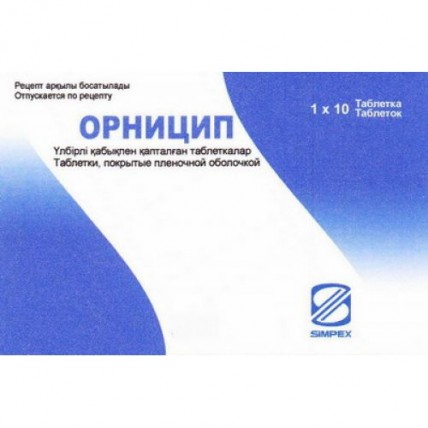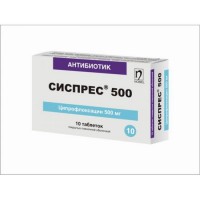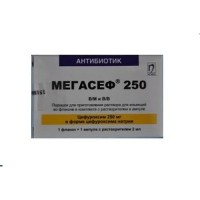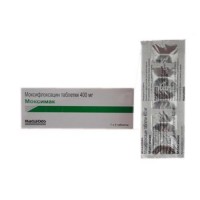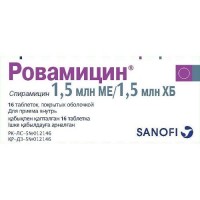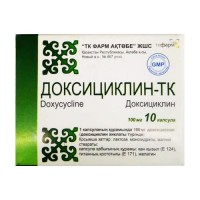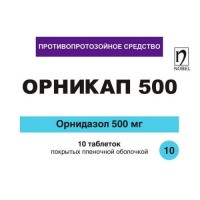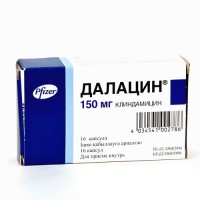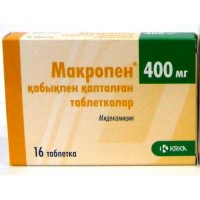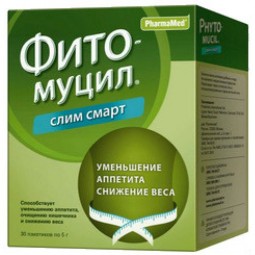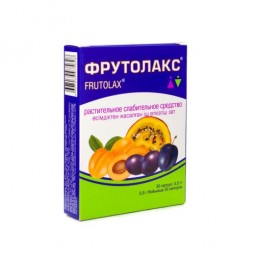Trade name
Ornitsip
Mezhdunarodnoye the unlicensed name
Is not present
the Dosage form
of the Tablet, film coated
Structure
One tablet contains
active agents:
ciprofloxacin a hydrochloride (it is equivalent to ciprofloxacin
of 583.00
mg 500.00 mg),
ornidazol
500 mg,
vsmopogatelny substances: microcrystalline cellulose, starch corn, krospovidon, silicon dioxide colloidal anhydrous, magnesium stearate, FCM yellow, methylene dichloride *, isopropyl alcohol *, propylene glycol.
* -
the Description
of the Tablet, film coated, yellow color, a capsulovidny form, with a biconvex surface, with risky on one party evaporates in the course of production.
Pharmakoterapichesy
Combination of Antimicrobial Drugs group.
ATX J01RA code
Pharmacological
Pharmacokinetics Ciprofloxacin properties. After intake, ciprofloxacin is quickly soaked up from the zheludochno-a intestinal path (ZIP). The maximum concentration (Cmax) in blood plasma from 0.8 to 3.9 mg/l is created in 1 - 2 h. The bioavailability of drug is about 70-80%. Linking of ciprofloxacin with proteins of blood plasma of 20-40%. 15-30% where it is metabolized with formation of 4 metabolites are exposed to biotransformation in a liver: diethylciprofloxacin, sulfociprofloxacin, oxociprofloxacin, N-formiltsiprofloksatsin. The volume of distribution is 2-3 l/kg. Easily gets into bodies and fabrics, passes through a blood-brain barrier (GEB), a placenta, it is allocated with breast milk. Concentration of ciprofloxacin in a phlegm, saliva, bones, peritoneal liquid, bile, a secret of a prostate and bodies of a small pelvis can exceed considerably appropriate level in blood serum. Ciprofloxacin and its metabolites are removed from an organism with urine (50-70%) and a stake (15-30%). Not changed ciprofloxacin is emitted with urine, by means of glomerular filtration and canalicular secretion. The renal clearance of ciprofloxacin - 3-5 ml/min., the general clearance of ciprofloxacin is 8-10 ml/min. Elimination half-life (T1/2) of ciprofloxacin at adults with normally functioning kidneys makes 3-5 hours of plasma.
Ornidazol. After intake ornidazol it is quickly soaked up in a GIT. The bioavailability of drug is about 90%. After reception of an oral dose of 1.5 g the maximum concentration (Cmax) in blood plasma, equal 30 mkg/ml, are reached in 3 hours after reception and decreases (Cmin) to 9 mkg/ml and 2.5 mkg/ml within 24 and 48 hours, respectively. After reception of an oral dose of 750 mg of Cmax in blood plasma, equal 11 mkg/ml, it was reached during from 2 to 3 hours after reception. After reception of an oral dose of 500 mg of Cmax in blood plasma, equal 7, 8 and 7 mkg/ml, it was reached during the periods at 1, 2 and 4 hours, respectively. Linking of an ornidazol with proteins of blood plasma makes about 15% and less. Ornidazol gets into cerebrospinal fluid, breast milk, passes through GEB and a placenta. Concentration of an ornidazol in vaginal liquid approximately same, as in blood plasma, is also reached 24 hours later after reception of a single oral dose. The volume of distribution is equal to about 0.9 l/kg.
Ornidazol is metabolized mainly in a liver, generally by hydrolysis and an oksidation. 5 metabolites of an ornidazol, two of which, metabolites 2 hydroxymethyl (M1) and alpha hydroxymethyl (M2) have antibacterial activity, are established, but are less active concerning Trichomonas vaginalis and anaerobic bacteria, than not changed ornidazol.
After single dose of 85% of a dose it is removed through kidneys during the first five days, mainly, a type of metabolites. About 4% of the accepted dose are allocated with kidneys in not changed look. The clearance of an ornidazol is from 45 to 50 ml/min. of blood plasma.
Through a GIT about 22% of an oral dose are removed. Biliary excretion of an ornidazol and its metabolites is sometimes observed.
Elimination half-life of an ornidazol (T1/2) about 13 hours. T1/2 of an ornidazol and its main metabolites of M1 and M2 it is extended at patients with abnormal liver functions.
Pharmacokinetics in special groups
Patients with a renal failure
Ciprofloxacin. At patients with the broken renal function the serumal concentration of ciprofloxacin are higher, and elimination half-life is extended up to 12 h. In the chronic kidney disease (CKD) (the clearance of creatinine (CC) is higher than 20 ml/min.) the percent of the drug removed through kidneys decreases, but cumulation in an organism does not happen owing to compensatory increase in metabolism of drug and removal through a GIT. Patients with a heavy renal failure (KK lower than 20 ml/min.) need to reduce the general daily dose half.
Ornidazol. The pharmacokinetics of an ornidazol does not change at depression of function of kidneys. Dose adjustment is not necessary. Ornidazol leaves at a hemodialysis. Therefore before a hemodialysis it is necessary to give an additional dose of an ornidazol of 500 mg, - if a daily dose of 2 g, and 250 mg if a daily dose - 1 g.
Patients with an abnormal liver function
Ciprofloxacin. Researches on ciprofloxacin kinetics at patients with a liver failure were not conducted.
Ornidazol. By results of a research at patients with cirrhosis the elimination half-life of an ornidazol is extended (22 hours instead of 13 hours) and the clearance of an ornidazol (35 instead from 45 to 50 ml/min.) in comparison with healthy volunteers decreases. Therefore the interval of dosing of an ornidazol at patients with heavy insufficiency of function of a liver has to be doubled.
A pharmacodynamics
Ornitsip – the combined antimicrobic and antiprotozoan drug which effect is caused by active components: ciprofloxacin (derivative generation fluorine-hinolona II) and an ornidazola (derivative 5 – a nitroimidazole).
Ciprofloxacin. Ciprofloxacin antimicrobial drug of a broad spectrum of activity, derivative quinoline, suppresses bacterial DNK-girazu (topoisomerases II and IV responsible for process of superspiralling of chromosomal DNA around nuclear RNA that is necessary for reading of genetic information), breaks DNA synthesis, growth and division of bacteria, causes the significant morphological changes of a bacterial cell (including a cell wall and membranes) and fast death of a bacterium.
Affects bakteritsidno gram-negative microorganisms during a dormant period and divisions (since influences not only DNA – a giraza, but also causes lysis of a cell wall), on gram-positive microorganisms – only during division.
The hypotoxicity for cells of a macroorganism is explained by lack of a DNA-giraza in them. Against the background of intake of ciprofloxacin there is no development of cross resistance to other antibiotics that does it highly effective against bacteria which are resistant, for example, to aminoglycosides, penicillin, cephalosporins, tetracyclines and many other antibiotics.
Gram-negative aerobic bacteria are sensitive to ciprofloxacin:
enterobakteriya (Escherichia coli, Salmonella spp., Shigella spp., Citrobacter spp., Klebsiella spp., Enterobacter spp., Proteus mirabilis, Proteus vulgaris, Serratia marcescens, Hafnia alvei, Edwardsiella tarda, Providencia spp., Morganella morganii, Vibrio spp., Yersinia spp.), other gram-negative bacteria (Haemophilus spp., Pseudomonas aeruginosa, Moraxella catarrhalis, Aeromonas spp., Pasteurella multocida, Plesiomonas shigelloides, Campylobacter jejuni, Neisseria spp.), some intracellular activators - Legionella pneumophila, Brucella spp., Listeria monocytogenes, Mycobacterium tuberculosis, Mycrobacterium kansasii, gram-positive aerobic bacteria: Staphylococcus spp. (Staphylococcus aureus, Staphylococcus haemolyticus, Staphylococcus hominis, Staphylococcus saprophyticus), Streptococcus spp. (Streptococcus pyogenes, Streptococcus agalactiae). It is active concerning Bacillus anthracis in vitro.
The majority of the stafilokkok resistant to Methicillinum, rezistentna and to ciprofloxacin. Sensitivity of Streptococcus pneumonia, Enterococcus faecalis, Mycobacterium avium (located intracellularly) – moderated (for their suppression high concentrations are required).
To rezistentna drug: Bacteroides fragilis, Pseudomonas cepacia, Pseudomonas maltophila, Ureaplasma urealyticum, Clostridium difficile, Nocardia asteroids. It is not effective concerning Treponema pallidum.
The resistance develops extremely slowly as, on the one hand, after effect of ciprofloxacin there is practically no persistent microorganism left, and with another – bacterial cells have no enzymes inactivating it.
Ornidazol. The mechanism of action of an ornidazol consists in biochemical restoration 5 nitrogroups of an ornidazol intracellular transport proteins of anaerobic microorganisms and protozoa. The restored 5 nitrogroup of an ornidazol interacts from DNA-microorganisms and inhibits synthesis of nucleic acid that leads to their death.
Ornidazol is effective at treatment of the protozoan infections caused by Trichomonas vaginalis, Gardnerella vaginalis, Giardia lamblia and Entamoeba histolytica and also concerning some causative agents of mephitic gangrenes - Peptostreptococcus, Peptococcus, Bacteroides, Clostridium and Fusobacterium (the minimum inhibiting concentration & lt, 4 mkg/ml).
Indications
Ornitsip is intended for treatment of the multi-infections caused sensitive to a combination ciprofloxacin / ornidazol by bacteria and protozoa:
- infectious and inflammatory diseases of an urinogenital system: the acute and chronic pyelonephritis, prostatitis, an epididymite cystitis complicated or recurrent infections of urinary tract
- infections, sexually transmitted: clamidiosis, mycoplasmosis, gonorrhea, trichomoniasis, multi-infections
the Route of administration and doses
Ornitsip's Dose and duration of treatment depend on sensitivity to it of microorganisms, weight and a type of infections, the general condition of the patient and functions of kidneys.
The pill Ornitsip should be taken inside to food or in 2 hours after a meal, washing down with a glass of water. A pill is taken without chewing.
In infectious and inflammatory diseases of an urinogenital system
- acute, uncomplicated infections - on 1 tablet each 12 hours within 3 days,
- acute cystitis at women (to a menopause) – 1 tablet once,
- an acute urethritis, prostatitis, an epididymite an orchiepididymitis, an adnexitis - on 1 tablet each 12 hours within 3 days,
- the chronic, complicated and recurrent infections - on 1 tablet each 12 hours within 7 days.
In infections, sexually transmitted
- uncomplicated gonorrhea (including the extragenital centers of an infection) - 1 tablet once,
- trichomoniasis – on 2 tablets once or a 5-day course of treatment on 1 tablet each 12 hours.
Drug treatment it is necessary to continue at least 3 more days after disappearance of symptoms of a disease and before full normalization of body temperature
Side effects
the Frequency of undesirable side effects about which it was reported, it is generalized below. Within each group of frequency of cases the undesirable by-effects are given in an order of reduction of gravity.
Chasto's ciprofloxacin (≥1/100, & lt, 1/10)
- lack of appetite, nausea, vomiting, an abdominal pain, a meteorism, diarrhea
- dizziness, a headache, a tremor
- skin rash, an itching, a small tortoiseshell
Seldom (≥1/10,000, ≤1/1000)
- sensation of fear, confusions, a depression, a disorder of vision, perceptions of a smell and taste, sweating strengthening, instability of gait, increase in intracranial pressure, a spasm, sleep disorder, excitement, hallucinations (these reactions demand immediate drug withdrawal)
- tachycardia, a lowering of arterial pressure
- a dysglycemia, is more often a hyperglycemia
- a glomerulonephritis, a dysuria, a crystalluria and a hamaturia
- a Quincke's edema, a bronchospasm
- an arthralgia, a swelling of joints
- candidiasis
- a photosensitization
- antibiotikoassotsirovanny colitis
Very seldom (≤1/10,000)
- feeling of inflows, migraine, an unconscious state
- lengthening of an interval Q-T, ventricular arrhythmia, ventricular tachycardia
- thrombosis of cerebral arteries, nasal bleeding
- dispnoe
- a leukopenia, an agranulocytosis, a zozinofiliya, thrombocytopenia, anemia, hemolytic anemia
- violent hemorrhagic rash, petechias, a knotty erythema, a vasculitis
- myalgia, arthritis, a tendovaginitis, ruptures of sinews
- tranzitorny increase in activity of ALT, nuclear heating plant and alkaline phosphatase, tranzitorny increase in creatinine, urea and serumal bilirubin
- Stephens-Johnson's syndrome, a Lyell's disease
- an acute anaphylaxis
- hepatitis, necrosis of cells of a liver, cholestatic jaundice, a tranzitorny liver failure
Ornidazol
Chasto (≥1/100, & lt, 1/10)
- dizziness, a headache
- dryness in a mouth, loss of appetite, a perversion of flavoring feelings, nausea, vomiting, dyspepsia, pains in epigastric area
is rare (≥1/10,000, ≤1/1000)
- trembling, rigidity, a lack of coordination of movements, spasms and disturbance of consciousness, disturbance of taste
- change of activity of liver ALT, nuclear Heating Plant enzymes
- a leukopenia (at long-term treatment)
- allergic reactions (skin rash, an itching)
Is very rare (≤1/10,000)
- symptoms of the touch or mixed peripheral neuropathy
of the Contraindication
- hypersensitivity to drug components
- hypersensitivity to derivatives of ftorkhinolin and derivatives of a nitroimidazole
- epilepsy, multiple sclerosis
- damage of the central nervous system with a reduced convulsive threshold (after craniocereberal injuries, a stroke, inflammatory processes of a brain and a meninx)
- existence of lengthening of an interval of Q-T on the ECG now or in the anamnesis
- a noncompensated hypopotassemia
- blood diseases, a leukopenia (including in the anamnesis)
- deficit glucose – 6 – fosfatdegidrogenaza
- simultaneous use with tizanidiny, with antiarrhythmic means of the class Ia (zinidin, procaineamide) or class III (Amiodaronum, sotakol)
- chronic kidney disease
- cirrhosis, a liver failure
- tendinites and ruptures of sinews after use of ftorkhinolin in the anamnesis
- children's and teenage age up to 18 years
- pregnancy and the period of a lactation
Medicinal interactions
At simultaneous use with antiacid, or ferriferous drugs, decrease of the activity of Ornitsip is possible. The interval between intake of the specified drugs and Ornitsip has to be not less than 4 hours.
The accompanying intake of aminoglycosides or beta laktamnykh antibiotics can cause synergy effects. At simultaneous use with warfarin the risk of bleeding increases. The concomitant use of Ornitsip with non-steroidal anti-inflammatory drugs (NPVP) (except for acetylsalicylic acid) increases risk of the stimulating influence on the central nervous system and increase risk of developing spasms.
Ciprofloxacin. The concomitant use of ciprofloxacin and glucocorticosteroids can increase risk of emergence of a rupture of sinews. Joint intake of ciprofloxacin with didanoziny reduces ciprofloxacin absorption, owing to formation of complexes of ciprofloxacin with the aluminum, magnesian salts which are contained in the didanozena.
The concomitant use of ciprofloxacin with theophylline can lead to increase in plasma concentration of theophylline and extension of its period of a poluvyvedeniyaa and emergence theophylline – the induced by-effects.
Probenetsid interferes with renal secretion of ciprofloxacin and promotes increase in level of concentration of ciprofloxacin in blood.
At simultaneous use of ciprofloxacin and cyclosporine the nephrotoxic effect of cyclosporine amplifies.
Simultaneous use of ciprofloxacin and warfarin can strengthen action of the last.
Simultaneous use of ciprofloxacin with antiarrhytmic drugs of the class Ia (zinidin, procaineamide) or class III (Amiodaronum, sotakol) is impossible as ciprofloxacin can increase prolongation of an interval of Q-T.
At co-administration of ciprofloxacin the delay of tubular transport (renal metabolism) of a methotrexate is possible that can lead to increase in concentration of a methotrexate in blood plasma. At the same time the probability of emergence of the side toxic reactions caused by a methotrexate increases.
Ornidazol. Ornidazol exponentiates effect of oral anticoagulants of a coumarinic row that demands the corresponding dose adjustment of Ornitsip.
Ornidazol extends myorelaxation action a bromide vekuroniya Concentration of an ornidazol decreases at simultaneous use with inductors of microsomal enzymes (phenobarbital, rifampicin) and increases at simultaneous use with inhibitors of microsomal systems of a liver, in particular, with H2 blockers – receptors (Cimetidinum), theophylline, insulin, antidiabetic means.
The combination of an ornidazol with neurotoxic and gematotoksichny drugs is not recommended.
Special instructions
the Patients receiving Ornitsip should avoid influence of direct sunshine, radiation by mercury-quartz lamps, visit of a sunbed because the risk of a photosensitization is high.
When performing therapy by Ornitsip, it is necessary to perform periodically examination of renal, hematologic systems, to monitor hepatic tests, especially at use of drug in high doses and in case of treatment over 10 days.
At persons with disturbances from blood in the anamnesis the control of leukocytes is recommended, especially when carrying out repeated courses of treatment.
Increase in expressiveness of disturbances from the central nervous system (CNS) or peripheral nervous system can be noted during performing drug treatment. In case of peripheral neuropathy, lacks of coordination of movements (ataxy), dizziness or turbidity of consciousness it is necessary to stop administration of drug.
Can reveal exacerbation of a candidiasis which will demand the corresponding treatment.
Ornitsip can affect results of crops on Mycobacterium spp flora. by oppression of growth in the culture of mycobacteria, resulting in false-negative results of the analysis of crops.
When prescribing the drug Ornitsip, it is necessary to consider that both active agents (and ciprofloxacin and ornidazol) can have side effects on the central nervous system that increases risk of developing a depression or psychosis. In such cases it is necessary to stop administration of drug and to immediately report about it to the doctor.
With care patients of advanced age should appoint Ornitsip. Patients of advanced age can have a high risk of lengthening of an interval of Q-T, especially patients with presence of risk factor have, for example, a prolongation of an interval of Q-T in the anamnesis and a nekorrigirovanny hypopotassemia.
At emergence of any symptoms of a tendinitis (for example a painful swelling, inflammation), it is necessary to tell the doctor and to stop treatment by Ornitsip. At the same time it is necessary to provide rest of the affected extremity and to avoid physical activity (as the risk of a rupture of a sinew can increase). The rupture of a sinew (mainly an akhillova) is more often observed at use of drug for elderly people or in connection with the previous treatment by glucocorticoids.
In case of emergence on an extent or after treatment of heavy and persistent diarrhea, it is necessary to report about it to the doctor as this symptom can mask a serious intestinal illness pseudomembranous colitis which can threaten life with a possible lethal outcome, the demanding immediate treatment and the corresponding therapy.
Prolonged use of Ornitsip can cause the consecutive infection connected with growth of microorganisms, resistant to drug.
The sick diabetes taking glucose-lowering drugs it is necessary to appoint Ornitsip with care.
It is necessary to avoid alcohol intake during treatment. Ornitsip is not compatible to alcohol since one of drug components ciprofloxacin at the combined use strengthens effect of ethanol (disulfiramopodobny reactions).
Features of influence of medicine on ability to run the vehicle or potentially dangerous mekhanizmamipr Ornitsip's reception the ability to concentration of attention and speed of psychomotor reactions can decrease that should be considered in need of use of drug for persons whose activity is connected with management of motor transport, service of machines and mechanisms.
Overdose
Symptoms: strengthening of side effects, such as dizziness, consciousness disturbance, attacks of epileptiform spasms, nausea, abdominal cavity pain, erosive injuries of mucous membranes of a GIT.
Treatment: it is necessary to cause vomiting, carry out symptomatic therapy, adequate hydration and gastric lavage.
Specific antidote does not exist. In spasms the prescribing of diazepam is recommended.
The form of release and packing
On 10 tablets place in blister strip packaging from a film of polyvinyldichloride and printing aluminum foil.
On 1 blister strip packaging together with the instruction for medical use in the state and Russian languages put in a cardboard pack.
To Store storage conditions in the dry, protected from light place, at a temperature not over 25 of 0C.
To store out of children's reach!
3 years
not to apply a period of storage after the expiry date specified on packing.
Prescription status
According to the prescription
the Producer
of Simpex of Pharm of Pvt. Ltd., India
to Develop
Ornitsip
Mezhdunarodnoye the unlicensed name
Is not present
the Dosage form
of the Tablet, film coated
Structure
One tablet contains
active agents:
ciprofloxacin a hydrochloride (it is equivalent to ciprofloxacin
of 583.00
mg 500.00 mg),
ornidazol
500 mg,
vsmopogatelny substances: microcrystalline cellulose, starch corn, krospovidon, silicon dioxide colloidal anhydrous, magnesium stearate, FCM yellow, methylene dichloride *, isopropyl alcohol *, propylene glycol.
* -
the Description
of the Tablet, film coated, yellow color, a capsulovidny form, with a biconvex surface, with risky on one party evaporates in the course of production.
Pharmakoterapichesy
Combination of Antimicrobial Drugs group.
ATX J01RA code
Pharmacological
Pharmacokinetics Ciprofloxacin properties. After intake, ciprofloxacin is quickly soaked up from the zheludochno-a intestinal path (ZIP). The maximum concentration (Cmax) in blood plasma from 0.8 to 3.9 mg/l is created in 1 - 2 h. The bioavailability of drug is about 70-80%. Linking of ciprofloxacin with proteins of blood plasma of 20-40%. 15-30% where it is metabolized with formation of 4 metabolites are exposed to biotransformation in a liver: diethylciprofloxacin, sulfociprofloxacin, oxociprofloxacin, N-formiltsiprofloksatsin. The volume of distribution is 2-3 l/kg. Easily gets into bodies and fabrics, passes through a blood-brain barrier (GEB), a placenta, it is allocated with breast milk. Concentration of ciprofloxacin in a phlegm, saliva, bones, peritoneal liquid, bile, a secret of a prostate and bodies of a small pelvis can exceed considerably appropriate level in blood serum. Ciprofloxacin and its metabolites are removed from an organism with urine (50-70%) and a stake (15-30%). Not changed ciprofloxacin is emitted with urine, by means of glomerular filtration and canalicular secretion. The renal clearance of ciprofloxacin - 3-5 ml/min., the general clearance of ciprofloxacin is 8-10 ml/min. Elimination half-life (T1/2) of ciprofloxacin at adults with normally functioning kidneys makes 3-5 hours of plasma.
Ornidazol. After intake ornidazol it is quickly soaked up in a GIT. The bioavailability of drug is about 90%. After reception of an oral dose of 1.5 g the maximum concentration (Cmax) in blood plasma, equal 30 mkg/ml, are reached in 3 hours after reception and decreases (Cmin) to 9 mkg/ml and 2.5 mkg/ml within 24 and 48 hours, respectively. After reception of an oral dose of 750 mg of Cmax in blood plasma, equal 11 mkg/ml, it was reached during from 2 to 3 hours after reception. After reception of an oral dose of 500 mg of Cmax in blood plasma, equal 7, 8 and 7 mkg/ml, it was reached during the periods at 1, 2 and 4 hours, respectively. Linking of an ornidazol with proteins of blood plasma makes about 15% and less. Ornidazol gets into cerebrospinal fluid, breast milk, passes through GEB and a placenta. Concentration of an ornidazol in vaginal liquid approximately same, as in blood plasma, is also reached 24 hours later after reception of a single oral dose. The volume of distribution is equal to about 0.9 l/kg.
Ornidazol is metabolized mainly in a liver, generally by hydrolysis and an oksidation. 5 metabolites of an ornidazol, two of which, metabolites 2 hydroxymethyl (M1) and alpha hydroxymethyl (M2) have antibacterial activity, are established, but are less active concerning Trichomonas vaginalis and anaerobic bacteria, than not changed ornidazol.
After single dose of 85% of a dose it is removed through kidneys during the first five days, mainly, a type of metabolites. About 4% of the accepted dose are allocated with kidneys in not changed look. The clearance of an ornidazol is from 45 to 50 ml/min. of blood plasma.
Through a GIT about 22% of an oral dose are removed. Biliary excretion of an ornidazol and its metabolites is sometimes observed.
Elimination half-life of an ornidazol (T1/2) about 13 hours. T1/2 of an ornidazol and its main metabolites of M1 and M2 it is extended at patients with abnormal liver functions.
Pharmacokinetics in special groups
Patients with a renal failure
Ciprofloxacin. At patients with the broken renal function the serumal concentration of ciprofloxacin are higher, and elimination half-life is extended up to 12 h. In the chronic kidney disease (CKD) (the clearance of creatinine (CC) is higher than 20 ml/min.) the percent of the drug removed through kidneys decreases, but cumulation in an organism does not happen owing to compensatory increase in metabolism of drug and removal through a GIT. Patients with a heavy renal failure (KK lower than 20 ml/min.) need to reduce the general daily dose half.
Ornidazol. The pharmacokinetics of an ornidazol does not change at depression of function of kidneys. Dose adjustment is not necessary. Ornidazol leaves at a hemodialysis. Therefore before a hemodialysis it is necessary to give an additional dose of an ornidazol of 500 mg, - if a daily dose of 2 g, and 250 mg if a daily dose - 1 g.
Patients with an abnormal liver function
Ciprofloxacin. Researches on ciprofloxacin kinetics at patients with a liver failure were not conducted.
Ornidazol. By results of a research at patients with cirrhosis the elimination half-life of an ornidazol is extended (22 hours instead of 13 hours) and the clearance of an ornidazol (35 instead from 45 to 50 ml/min.) in comparison with healthy volunteers decreases. Therefore the interval of dosing of an ornidazol at patients with heavy insufficiency of function of a liver has to be doubled.
A pharmacodynamics
Ornitsip – the combined antimicrobic and antiprotozoan drug which effect is caused by active components: ciprofloxacin (derivative generation fluorine-hinolona II) and an ornidazola (derivative 5 – a nitroimidazole).
Ciprofloxacin. Ciprofloxacin antimicrobial drug of a broad spectrum of activity, derivative quinoline, suppresses bacterial DNK-girazu (topoisomerases II and IV responsible for process of superspiralling of chromosomal DNA around nuclear RNA that is necessary for reading of genetic information), breaks DNA synthesis, growth and division of bacteria, causes the significant morphological changes of a bacterial cell (including a cell wall and membranes) and fast death of a bacterium.
Affects bakteritsidno gram-negative microorganisms during a dormant period and divisions (since influences not only DNA – a giraza, but also causes lysis of a cell wall), on gram-positive microorganisms – only during division.
The hypotoxicity for cells of a macroorganism is explained by lack of a DNA-giraza in them. Against the background of intake of ciprofloxacin there is no development of cross resistance to other antibiotics that does it highly effective against bacteria which are resistant, for example, to aminoglycosides, penicillin, cephalosporins, tetracyclines and many other antibiotics.
Gram-negative aerobic bacteria are sensitive to ciprofloxacin:
enterobakteriya (Escherichia coli, Salmonella spp., Shigella spp., Citrobacter spp., Klebsiella spp., Enterobacter spp., Proteus mirabilis, Proteus vulgaris, Serratia marcescens, Hafnia alvei, Edwardsiella tarda, Providencia spp., Morganella morganii, Vibrio spp., Yersinia spp.), other gram-negative bacteria (Haemophilus spp., Pseudomonas aeruginosa, Moraxella catarrhalis, Aeromonas spp., Pasteurella multocida, Plesiomonas shigelloides, Campylobacter jejuni, Neisseria spp.), some intracellular activators - Legionella pneumophila, Brucella spp., Listeria monocytogenes, Mycobacterium tuberculosis, Mycrobacterium kansasii, gram-positive aerobic bacteria: Staphylococcus spp. (Staphylococcus aureus, Staphylococcus haemolyticus, Staphylococcus hominis, Staphylococcus saprophyticus), Streptococcus spp. (Streptococcus pyogenes, Streptococcus agalactiae). It is active concerning Bacillus anthracis in vitro.
The majority of the stafilokkok resistant to Methicillinum, rezistentna and to ciprofloxacin. Sensitivity of Streptococcus pneumonia, Enterococcus faecalis, Mycobacterium avium (located intracellularly) – moderated (for their suppression high concentrations are required).
To rezistentna drug: Bacteroides fragilis, Pseudomonas cepacia, Pseudomonas maltophila, Ureaplasma urealyticum, Clostridium difficile, Nocardia asteroids. It is not effective concerning Treponema pallidum.
The resistance develops extremely slowly as, on the one hand, after effect of ciprofloxacin there is practically no persistent microorganism left, and with another – bacterial cells have no enzymes inactivating it.
Ornidazol. The mechanism of action of an ornidazol consists in biochemical restoration 5 nitrogroups of an ornidazol intracellular transport proteins of anaerobic microorganisms and protozoa. The restored 5 nitrogroup of an ornidazol interacts from DNA-microorganisms and inhibits synthesis of nucleic acid that leads to their death.
Ornidazol is effective at treatment of the protozoan infections caused by Trichomonas vaginalis, Gardnerella vaginalis, Giardia lamblia and Entamoeba histolytica and also concerning some causative agents of mephitic gangrenes - Peptostreptococcus, Peptococcus, Bacteroides, Clostridium and Fusobacterium (the minimum inhibiting concentration & lt, 4 mkg/ml).
Indications
Ornitsip is intended for treatment of the multi-infections caused sensitive to a combination ciprofloxacin / ornidazol by bacteria and protozoa:
- infectious and inflammatory diseases of an urinogenital system: the acute and chronic pyelonephritis, prostatitis, an epididymite cystitis complicated or recurrent infections of urinary tract
- infections, sexually transmitted: clamidiosis, mycoplasmosis, gonorrhea, trichomoniasis, multi-infections
the Route of administration and doses
Ornitsip's Dose and duration of treatment depend on sensitivity to it of microorganisms, weight and a type of infections, the general condition of the patient and functions of kidneys.
The pill Ornitsip should be taken inside to food or in 2 hours after a meal, washing down with a glass of water. A pill is taken without chewing.
In infectious and inflammatory diseases of an urinogenital system
- acute, uncomplicated infections - on 1 tablet each 12 hours within 3 days,
- acute cystitis at women (to a menopause) – 1 tablet once,
- an acute urethritis, prostatitis, an epididymite an orchiepididymitis, an adnexitis - on 1 tablet each 12 hours within 3 days,
- the chronic, complicated and recurrent infections - on 1 tablet each 12 hours within 7 days.
In infections, sexually transmitted
- uncomplicated gonorrhea (including the extragenital centers of an infection) - 1 tablet once,
- trichomoniasis – on 2 tablets once or a 5-day course of treatment on 1 tablet each 12 hours.
Drug treatment it is necessary to continue at least 3 more days after disappearance of symptoms of a disease and before full normalization of body temperature
Side effects
the Frequency of undesirable side effects about which it was reported, it is generalized below. Within each group of frequency of cases the undesirable by-effects are given in an order of reduction of gravity.
Chasto's ciprofloxacin (≥1/100, & lt, 1/10)
- lack of appetite, nausea, vomiting, an abdominal pain, a meteorism, diarrhea
- dizziness, a headache, a tremor
- skin rash, an itching, a small tortoiseshell
Seldom (≥1/10,000, ≤1/1000)
- sensation of fear, confusions, a depression, a disorder of vision, perceptions of a smell and taste, sweating strengthening, instability of gait, increase in intracranial pressure, a spasm, sleep disorder, excitement, hallucinations (these reactions demand immediate drug withdrawal)
- tachycardia, a lowering of arterial pressure
- a dysglycemia, is more often a hyperglycemia
- a glomerulonephritis, a dysuria, a crystalluria and a hamaturia
- a Quincke's edema, a bronchospasm
- an arthralgia, a swelling of joints
- candidiasis
- a photosensitization
- antibiotikoassotsirovanny colitis
Very seldom (≤1/10,000)
- feeling of inflows, migraine, an unconscious state
- lengthening of an interval Q-T, ventricular arrhythmia, ventricular tachycardia
- thrombosis of cerebral arteries, nasal bleeding
- dispnoe
- a leukopenia, an agranulocytosis, a zozinofiliya, thrombocytopenia, anemia, hemolytic anemia
- violent hemorrhagic rash, petechias, a knotty erythema, a vasculitis
- myalgia, arthritis, a tendovaginitis, ruptures of sinews
- tranzitorny increase in activity of ALT, nuclear heating plant and alkaline phosphatase, tranzitorny increase in creatinine, urea and serumal bilirubin
- Stephens-Johnson's syndrome, a Lyell's disease
- an acute anaphylaxis
- hepatitis, necrosis of cells of a liver, cholestatic jaundice, a tranzitorny liver failure
Ornidazol
Chasto (≥1/100, & lt, 1/10)
- dizziness, a headache
- dryness in a mouth, loss of appetite, a perversion of flavoring feelings, nausea, vomiting, dyspepsia, pains in epigastric area
is rare (≥1/10,000, ≤1/1000)
- trembling, rigidity, a lack of coordination of movements, spasms and disturbance of consciousness, disturbance of taste
- change of activity of liver ALT, nuclear Heating Plant enzymes
- a leukopenia (at long-term treatment)
- allergic reactions (skin rash, an itching)
Is very rare (≤1/10,000)
- symptoms of the touch or mixed peripheral neuropathy
of the Contraindication
- hypersensitivity to drug components
- hypersensitivity to derivatives of ftorkhinolin and derivatives of a nitroimidazole
- epilepsy, multiple sclerosis
- damage of the central nervous system with a reduced convulsive threshold (after craniocereberal injuries, a stroke, inflammatory processes of a brain and a meninx)
- existence of lengthening of an interval of Q-T on the ECG now or in the anamnesis
- a noncompensated hypopotassemia
- blood diseases, a leukopenia (including in the anamnesis)
- deficit glucose – 6 – fosfatdegidrogenaza
- simultaneous use with tizanidiny, with antiarrhythmic means of the class Ia (zinidin, procaineamide) or class III (Amiodaronum, sotakol)
- chronic kidney disease
- cirrhosis, a liver failure
- tendinites and ruptures of sinews after use of ftorkhinolin in the anamnesis
- children's and teenage age up to 18 years
- pregnancy and the period of a lactation
Medicinal interactions
At simultaneous use with antiacid, or ferriferous drugs, decrease of the activity of Ornitsip is possible. The interval between intake of the specified drugs and Ornitsip has to be not less than 4 hours.
The accompanying intake of aminoglycosides or beta laktamnykh antibiotics can cause synergy effects. At simultaneous use with warfarin the risk of bleeding increases. The concomitant use of Ornitsip with non-steroidal anti-inflammatory drugs (NPVP) (except for acetylsalicylic acid) increases risk of the stimulating influence on the central nervous system and increase risk of developing spasms.
Ciprofloxacin. The concomitant use of ciprofloxacin and glucocorticosteroids can increase risk of emergence of a rupture of sinews. Joint intake of ciprofloxacin with didanoziny reduces ciprofloxacin absorption, owing to formation of complexes of ciprofloxacin with the aluminum, magnesian salts which are contained in the didanozena.
The concomitant use of ciprofloxacin with theophylline can lead to increase in plasma concentration of theophylline and extension of its period of a poluvyvedeniyaa and emergence theophylline – the induced by-effects.
Probenetsid interferes with renal secretion of ciprofloxacin and promotes increase in level of concentration of ciprofloxacin in blood.
At simultaneous use of ciprofloxacin and cyclosporine the nephrotoxic effect of cyclosporine amplifies.
Simultaneous use of ciprofloxacin and warfarin can strengthen action of the last.
Simultaneous use of ciprofloxacin with antiarrhytmic drugs of the class Ia (zinidin, procaineamide) or class III (Amiodaronum, sotakol) is impossible as ciprofloxacin can increase prolongation of an interval of Q-T.
At co-administration of ciprofloxacin the delay of tubular transport (renal metabolism) of a methotrexate is possible that can lead to increase in concentration of a methotrexate in blood plasma. At the same time the probability of emergence of the side toxic reactions caused by a methotrexate increases.
Ornidazol. Ornidazol exponentiates effect of oral anticoagulants of a coumarinic row that demands the corresponding dose adjustment of Ornitsip.
Ornidazol extends myorelaxation action a bromide vekuroniya Concentration of an ornidazol decreases at simultaneous use with inductors of microsomal enzymes (phenobarbital, rifampicin) and increases at simultaneous use with inhibitors of microsomal systems of a liver, in particular, with H2 blockers – receptors (Cimetidinum), theophylline, insulin, antidiabetic means.
The combination of an ornidazol with neurotoxic and gematotoksichny drugs is not recommended.
Special instructions
the Patients receiving Ornitsip should avoid influence of direct sunshine, radiation by mercury-quartz lamps, visit of a sunbed because the risk of a photosensitization is high.
When performing therapy by Ornitsip, it is necessary to perform periodically examination of renal, hematologic systems, to monitor hepatic tests, especially at use of drug in high doses and in case of treatment over 10 days.
At persons with disturbances from blood in the anamnesis the control of leukocytes is recommended, especially when carrying out repeated courses of treatment.
Increase in expressiveness of disturbances from the central nervous system (CNS) or peripheral nervous system can be noted during performing drug treatment. In case of peripheral neuropathy, lacks of coordination of movements (ataxy), dizziness or turbidity of consciousness it is necessary to stop administration of drug.
Can reveal exacerbation of a candidiasis which will demand the corresponding treatment.
Ornitsip can affect results of crops on Mycobacterium spp flora. by oppression of growth in the culture of mycobacteria, resulting in false-negative results of the analysis of crops.
When prescribing the drug Ornitsip, it is necessary to consider that both active agents (and ciprofloxacin and ornidazol) can have side effects on the central nervous system that increases risk of developing a depression or psychosis. In such cases it is necessary to stop administration of drug and to immediately report about it to the doctor.
With care patients of advanced age should appoint Ornitsip. Patients of advanced age can have a high risk of lengthening of an interval of Q-T, especially patients with presence of risk factor have, for example, a prolongation of an interval of Q-T in the anamnesis and a nekorrigirovanny hypopotassemia.
At emergence of any symptoms of a tendinitis (for example a painful swelling, inflammation), it is necessary to tell the doctor and to stop treatment by Ornitsip. At the same time it is necessary to provide rest of the affected extremity and to avoid physical activity (as the risk of a rupture of a sinew can increase). The rupture of a sinew (mainly an akhillova) is more often observed at use of drug for elderly people or in connection with the previous treatment by glucocorticoids.
In case of emergence on an extent or after treatment of heavy and persistent diarrhea, it is necessary to report about it to the doctor as this symptom can mask a serious intestinal illness pseudomembranous colitis which can threaten life with a possible lethal outcome, the demanding immediate treatment and the corresponding therapy.
Prolonged use of Ornitsip can cause the consecutive infection connected with growth of microorganisms, resistant to drug.
The sick diabetes taking glucose-lowering drugs it is necessary to appoint Ornitsip with care.
It is necessary to avoid alcohol intake during treatment. Ornitsip is not compatible to alcohol since one of drug components ciprofloxacin at the combined use strengthens effect of ethanol (disulfiramopodobny reactions).
Features of influence of medicine on ability to run the vehicle or potentially dangerous mekhanizmamipr Ornitsip's reception the ability to concentration of attention and speed of psychomotor reactions can decrease that should be considered in need of use of drug for persons whose activity is connected with management of motor transport, service of machines and mechanisms.
Overdose
Symptoms: strengthening of side effects, such as dizziness, consciousness disturbance, attacks of epileptiform spasms, nausea, abdominal cavity pain, erosive injuries of mucous membranes of a GIT.
Treatment: it is necessary to cause vomiting, carry out symptomatic therapy, adequate hydration and gastric lavage.
Specific antidote does not exist. In spasms the prescribing of diazepam is recommended.
The form of release and packing
On 10 tablets place in blister strip packaging from a film of polyvinyldichloride and printing aluminum foil.
On 1 blister strip packaging together with the instruction for medical use in the state and Russian languages put in a cardboard pack.
To Store storage conditions in the dry, protected from light place, at a temperature not over 25 of 0C.
To store out of children's reach!
3 years
not to apply a period of storage after the expiry date specified on packing.
Prescription status
According to the prescription
the Producer
of Simpex of Pharm of Pvt. Ltd., India
to Develop
